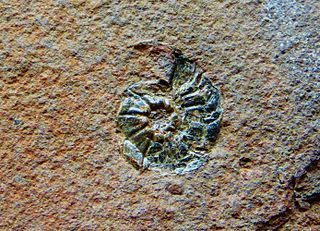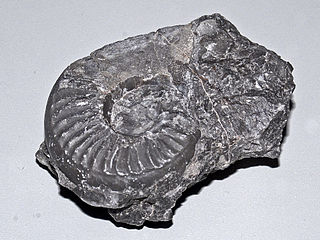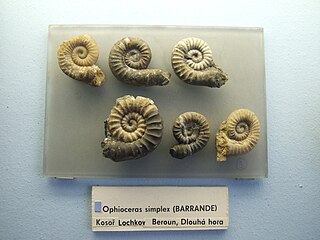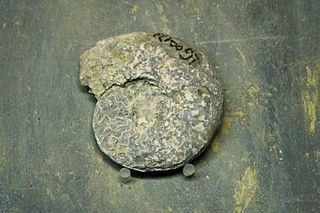Xenoceltites is an extinct genus of ceratite ammonoid found worldwide in the Lower Triassic.

Alsatites is an extinct genus of cephalopod belonging to the Ammonite subclass. They lived during the Hettangian and are generally extremely evolute, many whorled. Keel broad and blunt organisms, they also exhibit a primary ribbing which is close and persistent.

Asklepioceras is a genus in the Ceratitid family Arpaditidae from the Middle and Upper Triassic of Italy, Romania, Turkey, and British Columbia (Canada).

Astieridiscus is an extinct lower Cretaceous ammonite. Its shell evolute, covered by dense, simple or branching, slightly flexuous ribs. The sides are slightly flattened, the venter rounded. No umbilical or other tubercles except on innermost whorl. Superficially resembles Olcostephanus.
Balkanites is a genus of extinct ammonites (s.l.), belonging to the ceratitid superfamily Ceratitacea and family Tirolitidae. It is restricted to the Triassic period. As common to the family, the shell is evolute with lateral tubercles. The suture is not elaborate.
Badiotites is a genus of extinct ammonoid cephalopods belonging to the ceratitid family Badiotitidae. It was previously included with Lecanites in the Lecanitidae, a family formerly of the Clydonitaceae but reassigned by Tozer (1981) to the Danubitaceae. The Badiotitidae is included in the Ceratitaceae.
Biltnerites is a genus of ammonites (s.l.) from the lower Triassic included in the ceratitacean family Tirolitidae of the order Ceratitida, characterized by a flat, evolute shell with moderately compressed, rounded whorls. The spinose stage characteristic of the Tirolitidae is absent, but the outer whorl does have indistinct ribs that cross the venter.

Ammonitina comprises a diverse suborder of ammonite cephalopods that lived during the Jurassic and Cretaceous periods of the Mesozoic Era. They are excellent index fossils, and it is often possible to link the rock layer in which they are found to specific geological time periods.

The Trigonoceratoidea are a superfamily within the Nautilida that ranged from the Devonian to the Triassic, thought to have contained the source for the Nautilaceae in which Nautilus is found.

Grypoceratidae is the longest-lived family of the Trigonoceratoidea, or of the near equivalent Centroceratina; members of the Nautilida from the Upper Paleozoic and Triassic.
Lecanites is a ceratitid genus assigned to the Danubitaceae, with an essentially smooth, evolute, discoidal shell and a goniatitic suture with many elements. It is the type and now only genus of the Lecanitidae.
Pinacoceratoidea, formerly Pinacocerataceae, are generally smooth, compressed, evolute to involute ammonoids from the Triassic, belonging to the Ceratitida, in which the suture is ammonitic, with adventitious and auxiliary elements.
Californites is a genus of the Upper Triassic clydonicoidean family Clionitidae with a discoidal, evolute shell and radial tuberculate ribs that end in strong ventrolateral spines. The whorl section is described as trapezoidal. The venter is low-arched, smooth, and has a strong but narrow median groove.

Tainoceratidae is a family of late Paleozoic and Triassic nautiloids that are a part of the order Nautilida, characterized by large, generally evolute shells with quadrate to rectangular whorl sections. Shells may bear ribs or nodes, or both.
Anoploceras is a genus of Middle and Upper Triassic nautiloids included in the Tainoceratidae, known from eastern Europe. The shell is evolute with only a slight overlap of previous whorls. Whorl section is subquadrate, like Pleuronautilus, only depressed. Flanks have conspicuous ribs that may be somewhat sinuous.

Ophioceras is a genus of closely coiled tarphycerid nautiloid cephalopods, the sole representatives of the family Ophidioceratidae, characterized by an evolute shell with narrow, subrounded, annulated whorls and a subcentral siphuncle composed of thin connecting rings that show no evidence of layering. The mature body chamber is strongly divergent and is the longest proportionally of any tarphycerid. The aperture has a deep hyponomic sinus and ocular sinuses, and so resembles some lituitids.

Gymnitidae is a family of Lower to Middle Triassic ammonite cephalopods with evolute, discoidal shells.

Spitidiscus is a genus of ammonites placed in the family Holcodiscidae.

Flemingites is an extinct genus of evolute ammonoid from the Smithian with spiral ridges on the shell.

Meekoceras is an extinct genus of ceratitid ammonites with a discoidal shell that lived during the Early Triassic Epoch.











